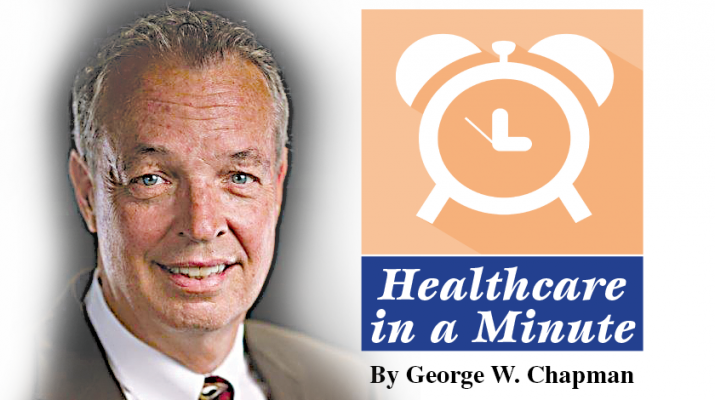By George W. Chapman
New HHS Secretary
The Senate recently confirmed physician Tom Price, a 12-year republican congressman from Georgia, as secretary of health and human services. Price is a former orthopedic surgeon.
He will be the first physician to be the secretary in 20 years. He faced rigorous opposition from democrats because of his investments in medical device companies shortly before he introduced legislation that would kill “bundled payments” for certain joint replacement surgeries. To control costs, hospitals would be paid a lump or bundled payment (say $50,000) which would cover all costs associated with the joint replacement procedure including hospital, surgeon, anesthesiologist, knee or hip implant, physical therapy, etc.
Being capped at $50,000, hospitals would have an incentive to lower costs by negotiating lower implant prices with the manufacturers. Price is an outspoken critic of the Affordable Care Act. The AMA was quick to endorse Price, hoping he could reduce the excessive regulatory burdens imposed on physicians.
Top 10 lobbyists
Last year, over 11,000 organizations spent over $3 billion lobbying the federal government. Although the lowest since 2007, experts expect the amount to increase as Trump looks to shake up the status quo on a lot of things, especially the Affordable Care Act. All the top lobbyists have some sort of stake in healthcare, be it: taxes, commercial insurance, Medicare, hospitals, device manufacturing, drugs, physicians, research, IT or the self-employed. The top 10 lobbyist by total spending, healthcare or otherwise, are: 1. US Chamber of Commerce: $75 million. 2. National Association of Realtors: $53 million. 3. Institute for Legal Reform: $28 million. 4. Pharmaceutical Research and Manufacturers: $20 million. 5. American Hospital Association: $19 million. 6. American Medical Association: $19 million. 7. Boeing: $17 million. 8. Business Roundtable: $16 million. 9. Google: $15 million. 10. Dow chemical: $13 million.
Most promising healthcare jobs
Using data from the US Bureau of Labor Statistics, LinkedIn evaluated the jobs in healthcare based on salaries, demand, annual growth and advancement opportunities. The rank: 1. pharmacy manager; 2. project manager; 3. compliance officer.; 4. hospitalist (MD); 5. financial analyst; 6. sales director (insurance); 7. pharmacist; 8. product manager; 9. program manager; 10. regional director of operations.
Hospital facts
There are 5,564 hospitals across the U.S. That total includes: academic/teaching, community, VA, long-term care, psychiatric, drug abuse and rehab hospitals. The vast majority, 85 percent, are your basic general or community hospital. About a third of all hospitals serve rural communities. 20 percent are state owned; 59 percent are nonprofit and 21 percent are for profit. (NYS does not allow for-profit hospitals). Hospital mergers declined slightly last year. There were 102 in 2016 vs, 112 in 2015. The five largest for-profit hospital systems, based on the number of hospitals in the system, are: Hospital Corp. of America, 169; Community Health Systems, 158; Tenet Healthcare, 79; lIfePoint Health, 72 and Prime Healthcare, 44. Three of these top five are based in Tennessee. The five largest nonprofits are: Ascension, 141; Catholic Health Initiatives, 103; Trinity, 92; Baylor, 48; Adventist, 46. The average length of stay in 2015 was about five days, but that is misleading considering the different types of hospitals. The average profit or operating margin for most nonprofits is around 1-2 percent.
ACA future
At this time, it seems there won’t be an immediate repeal and replacement of “ObamaCare.” Congress is discovering the ACA is far more complex. While applauding the selection of Tom Price, five physician specialty organizations have asked congress to consider the following when they tinker with the ACA. 1. Do not increase the number of uninsured. 2. Protect the healthcare safety net. 3. Protect consumers from excessive insurance costs. (This should apply to ALL Americans, not just the 20 million covered by the ACA). 4. Maintain premium subsidies currently received by about 7 million people. 5. Protect small insurance markets.
Right to die
This highly charged and controversial topic has been brought to the forefront again by the nomination of Neil Gorsuch to the Supreme Court. He is on record as being deeply opposed to physician-assisted suicide or euthanasia. His belief is based upon the premise that all humans are intrinsically valuable and the intentional taking of another life by a private person is always wrong. Five states have passed “death with dignity” laws: Oregon, Washington, California, Vermont and Colorado. These laws allow physician-assisted death for terminally ill patients. This issue confronts physicians with a conundrum. On one hand they pledge to do no harm. On the other hand they may be forcing people to go through a prolonged and painful death. Participating in an assisted death is clearly up to the individual physician. In the meantime, Vice President Mike Pence is in favor of a “right to try” law that would allow terminal patients to receive experimental, not yet finally approved drugs.
Health information
To research just about any health issue, from A to Z, try www.health.ny.gov/healthaz www.health.ny.gov/healthaz. Being informed makes you a better partner with your physician.
George W. Chapman is a healthcare business consultant who works exclusively with physicians, hospitals and healthcare organizations. He operates GW Chapman Consulting based in Syracuse. Email him at gwc@gwchapmanconsulting.com.

